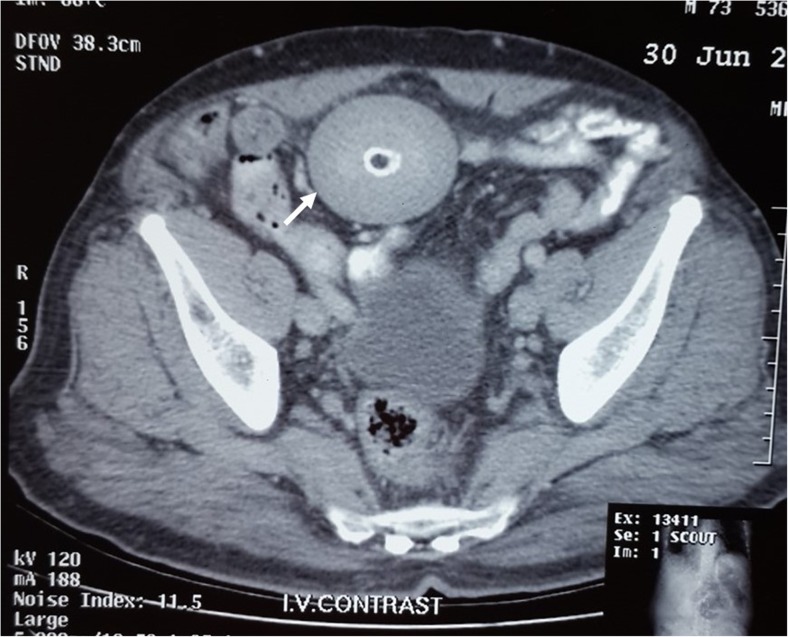Abstract
We report a large, asymptomatic, intraperitoneal loose body in a 72-year-old male, presented with bilateral inguinal hernia.
Keywords: Loose body, Intraperitoneal, Laparoscopic
A 72-year-old male presented with bilateral inguinal hernia. There was an incidental, circumscribed, oval, asymptomatic mass in the abdomen detected in ultrasonography and confirmed by CT scan (Fig. 1). The patient underwent diagnostic laparoscopy and found to have freely moving large, oval, egg-like mass (Fig. 2a) in the pelvis antero-superior to the urinary bladder surrounded by the small bowel and omentum, but not attached to them. Diagnosis of “peritoneal loose body” was made and the mass was delivered through a small Pfannenstiel incision.
Fig. 1.
CECT abdomen showing intraperitoneal loose body (arrow)
Fig. 2.
a Gross view of loose body after extraction. b Cross-sectional view of loose body with a nidus at the center (arrow)
Grossly, the mass had a large egg-like appearance with size of about 6.5 × 6.0 × 4.5 cm. Cut section shows a central nidus (Fig. 2b).
On histopathological examination, the mass was composed of collagenous tissue with a central adipose tissue, which at places showed calcification.
Peritoneal loose bodies are extremely rare. The possible origin is torsion of appendix epiploicae and detachment, followed by calcification [1, 2]. Over a long period of time, there may be deposition of collagenous material from serum forming these types of loose bodies. In our case, central adipose tissue in histopathological examination supports this theory of origin.
Compliance with Ethical Standards
Conflict of Interest
The authors declare that they have no conflict of interest.
References
- 1.Sewkani A, Jain A, Maudar KK, Varshney S. ‘Boiled egg’ in the peritoneal cavity—a giant peritoneal loose body in a 64-year-old man: a case report. J Med Case Rep. 2011;5:297. doi: 10.1186/1752-1947-5-297. [DOI] [PMC free article] [PubMed] [Google Scholar]
- 2.Sussman R, Murdock J. Peritoneal loose body. NEJM. 2015;372:1359. doi: 10.1056/NEJMicm1316094. [DOI] [PubMed] [Google Scholar]




